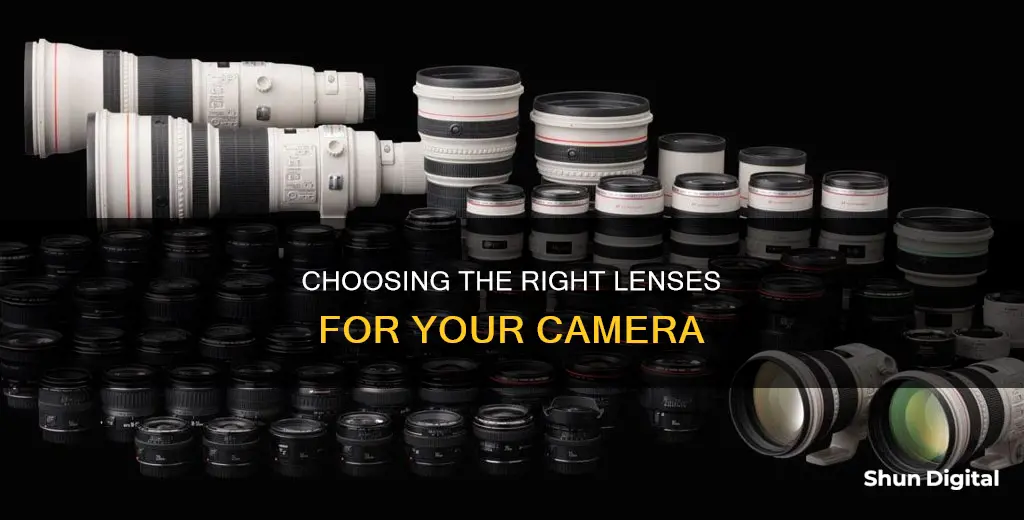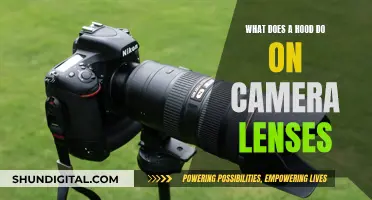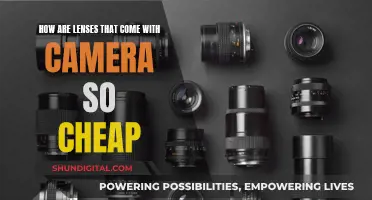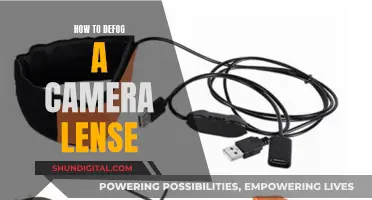
Choosing the right lens for your camera can be a complicated process. The first step is to identify the type of camera you have, whether it's a DSLR or a mirrorless camera, and whether it's full-frame or a crop sensor camera. The next step is to determine the lens mount type. This is the junction where the camera and lens meet and is usually indicated by a symbol or marking on the lens mount. Different camera brands have different lens mounts, so it's important to buy a lens that is compatible with your camera's lens mount. Third-party lens manufacturers like Sigma and Tamron also produce lenses that fit a range of different camera brands. Finally, you may need to consider using a lens adapter if you want to use a lens that is not natively compatible with your camera's lens mount.
What You'll Learn

Canon EOS camera lenses
Canon's EF mount lenses are compatible with both full-frame and APS-C Canon EOS cameras. EF-mount lenses are also compatible with all EOS cameras, including film and all formats of digital sensors. However, EF-S mount lenses, designed for APS-C sensor cameras, are more specialised and not compatible with full-frame models. RF-mount lenses are exclusive to the EOS R series of mirrorless cameras. Canon's EF-M mount lenses are designed for the EOS M series, their compact range of mirrorless cameras.
Canon cameras have four mount types. If your camera has a red line on the lens mount, it is an EOS APS-C R System or EOS Full-frame R System mirrorless. A red circle and a white square indicate an EOS APS-C DSLR, while a solitary red circle denotes an EOS full-frame DSLR. Finally, a white circle on the lens mount means your camera is an EOS M series APS-C mirrorless.
Canon lens adapters offer full compatibility with Canon EF, EF-S, TS-E, and MP-E lenses, giving EOS R System and EOS M series camera owners complete integration with their existing lenses. The standard Mount Adapter EF-EOS R allows EF, EF-S, TS-E, and MP-E lenses to be used with EOS R System cameras. The Control Ring Mount Adapter EF-EOS R offers the same conversion but adds a lens control ring. The Drop-In Filter Mount Adapter EF-EOS R adds drop-in filter functionality to the standard adapter. The Mount Adapter EF-EOS M is a small, lightweight adapter that allows you to attach any lens from Canon's EF, EF-S, TS-E, and MP-E range to the EOS M series camera.
Choosing the Right Camera Lenses: A Quick Guide
You may want to see also

Canon EF-S mount cameras
Canon EF-S mount lenses are designed for Canon EOS APS-C DSLR cameras. They are also compatible with Canon EOS R System and EOS M series cameras, but only when used with the appropriate lens adapter. Canon EF-S lenses are not compatible with full-frame DSLR or mirrorless cameras.
The EF-S lens mount is one of four types of lens mounts used by Canon cameras. The other three types are the EOS R System, the EOS M series, and the EOS full-frame DSLR. Each of these lens mounts is designed for a specific type of Canon camera, and not all lenses are compatible with all camera models.
Canon EF-S lenses are designed to work with APS-C sensor cameras, which have a smaller sensor size than full-frame cameras. This means that EF-S lenses create a smaller image circle, which is fully compatible with APS-C sensors. While EF-S lenses can be used on full-frame cameras with an adapter, the image will appear cropped or zoomed-in due to the smaller image circle.
Canon EF-S lenses offer a range of options for photographers using APS-C DSLR cameras. They provide a cost-effective alternative to full-frame lenses, as they are typically smaller and more affordable while still delivering impressive image quality. EF-S lenses are also backward compatible with older Canon autofocus film SLR cameras, providing even more options for photographers.
When choosing lenses for a Canon EF-S mount camera, it is important to consider the specific photography needs and preferences. EF-S lenses are available in various types, including prime lenses, zoom lenses, and telephoto lenses, each offering unique features and benefits. By understanding the camera's lens mount and sensor size, photographers can make informed decisions about lens choices and ensure compatibility with their Canon EF-S mount camera.
Sigma Lenses: Compatibility Across Camera Brands
You may want to see also

Nikon F-mount cameras
The Nikon F-mount is a type of interchangeable lens mount developed by Nikon for its 35mm format single-lens reflex cameras. The F-mount was first introduced on the Nikon F camera in 1959 and has been in production for over 60 years, making it the only SLR lens mount with such longevity. The F-mount is also one of only two SLR lens mounts (the other being the Pentax K-mount) that were not abandoned by their associated manufacturer upon the introduction of autofocus.
The F-mount has a bayonet-type structure that serves as the communication link between Nikon SLRs and NIKKOR lenses. It is noted for its rugged construction, outstanding reliability, and degree of compatibility with NIKKOR lenses. Nikon has maintained the basic structure of the mount over the years, with some variations, to accommodate future system advances.
There are over 400 different Nikkor lenses compatible with the F-mount system, including AF Nikkor, AF-S (Silent Wave Motor), and PC-E perspective-control Nikkor lenses. Additionally, other well-known lens manufacturers such as Samyang, Sigma, Tamron, Tokina, Irix, and Zeiss produce lenses for the F-mount.
When choosing lenses for your Nikon F-mount camera, it's important to consider the type of photography you want to do. Here are some common types of lenses and their uses:
- Macro lenses: These lenses focus much closer than normal lenses, allowing you to capture small subjects like insects, flowers, or even stamp collections. They typically have a magnification of 1:1 or 1x, meaning a 1cm object would appear as 1cm on the sensor. Some macro lenses can focus down to half life-size, or 1:2.
- Wide-angle lenses: These lenses offer a wider field of view than standard lenses, making them ideal for landscapes and architectural photography. They provide a unique perspective and creative opportunities but may require a tripod for critical focusing.
- Standard lenses: For full-frame cameras, the standard 50mm lens has been a popular choice, offering a field of view similar to that of the human eye. These lenses are versatile and can be used for street photography, portraits, and even close-up shots with the addition of extension tubes or teleconverters.
- Telephoto lenses: Telephoto lenses are useful for bringing distant subjects closer, such as in sports or wildlife photography. They are also commonly used for portraits, with short telephoto lenses like 85mm or 100mm offering a more flattering perspective than wider lenses.
- Zoom lenses: Zoom lenses offer convenience and versatility, especially for travel and sports photography. They cover a range of focal lengths but typically have more restricted apertures, requiring higher ISO values to maintain fast shutter speeds.
Squaretrade Coverage for Camera Lenses: What You Need to Know
You may want to see also

Sony E-mount cameras
When it comes to lenses for Sony E-mount cameras, there are a few things to keep in mind. Firstly, it's important to distinguish between the E-mount and the FE-mount. The E-mount is designed for Sony's APS-C mirrorless cameras, while the FE-mount is for their full-frame mirrorless cameras.
If you have an E-mount camera, you can use E-mount lenses, which are designed specifically for APS-C sensors. These lenses are often smaller and more affordable than their full-frame counterparts. It's worth noting that you can also use FE-mount lenses on an E-mount camera, but you'll need to use "crop mode", which will result in a lower resolution.
On the other hand, if you have an FE-mount camera, you have a few more options. You can use FE-mount lenses, which are designed for full-frame sensors and will provide the best performance. Additionally, you can adapt older A-mount lenses, which were used on Sony's DSLRs, to work on your FE-mount camera with full features, including autofocus.
It's also worth mentioning that Sony has recently discontinued its A-mount DSLRs, so there may be limited support for this mount in the future. However, with the right adapter, you can use A-mount lenses on both E-mount and FE-mount cameras.
In summary, the lenses that fit your Sony E-mount camera will depend on whether it is an E-mount or FE-mount model. E-mount lenses are designed for APS-C sensors, while FE-mount lenses are for full-frame sensors. With the appropriate adapters, you can also use A-mount lenses, providing you with a range of options to choose from.
Understanding Camera Lenses: Decoding Focal Length Numbers
You may want to see also

Sigma lenses
Sigma offers a wide range of lenses for mirrorless cameras and DSLRs. The Sigma DG DN lenses are designed for full-frame mirrorless cameras and are compatible with Sony E-Mount and L-Mount cameras from Sigma, Leica, and Panasonic. Sigma also offers the DC DN lenses, which are designed for mirrorless crop-sensor cameras and are compatible with Sony E-Mount, Canon EF-M, Micro Four Thirds, and L-Mount cameras.
Sigma also has a range of fast-aperture prime lenses in the Art line, which are compatible with both full-frame mirrorless and DSLR cameras. These lenses are available for Canon EF, Nikon F, Sony E-Mount, and L-Mount systems.
Additionally, Sigma provides adapters that allow photographers to use their Sigma Art, Sports, and Contemporary lenses with Canon EF mounts on Sony E-Mount and L-Mount cameras. The Sigma MC-11 adapter is used for Sony E-Mount, while the Sigma MC-21 adapter is for L-Mount cameras.
Sigma does not currently offer lenses for Canon RF, Nikon Z, or Fujifilm X mounts. However, they suggest using OEM mount adapters to pair Canon EF or Nikon F mount lenses with mirrorless cameras from these brands.
Tamron Lenses: Compatible Camera Guide for Photographers
You may want to see also
Frequently asked questions
The junction where your camera meets the lens is called the mount. You need to ensure the lens is compatible with your camera's mount. Most major companies use their own proprietary mount, so if you want to use a lens on your Canon camera, you’ll have to buy a Canon lens, or buy a lens from a third-party company that makes models in that specific mount.
Canon cameras have four mount types. If you see a red line on the lens mount, your camera is an EOS APS-C R System or EOS Full-frame R System mirrorless. If you see a red circle and a white square on the lens mount, your camera is an EOS APS-C DSLR. If you see only a red circle on the lens mount, your camera is an EOS full-frame DSLR. If you see a white circle on the lens mount, your camera is an EOS M series APS-C mirrorless.
Canon uses one of three lens mounts: the standard EF mount and then two derivatives, the EF-S mount, and the EF-M mount. The EF-S mount is used by Canon’s crop-sensor cameras, and the EF-M mount was created for Canon’s mirrorless cameras.
Nikon has two sensor sizes: the FX full-frame sensor and the DX APS-C sensor. There are lenses available for each that use the F-mount. Nikon also has a mirrorless mount: the Nikon 1 mount. Nikon 1 lenses can only be used with Nikon 1 cameras, although F-mount lenses can be used with an adapter.
Sony's DSLT systems use the Alpha lens mount, which is different from the E-mount system that Sony uses for its mirrorless system cameras. When buying lenses for full-frame mirrorless Sony cameras, ensure that the lens has the markings 'FE' to indicate that it's full-frame.







